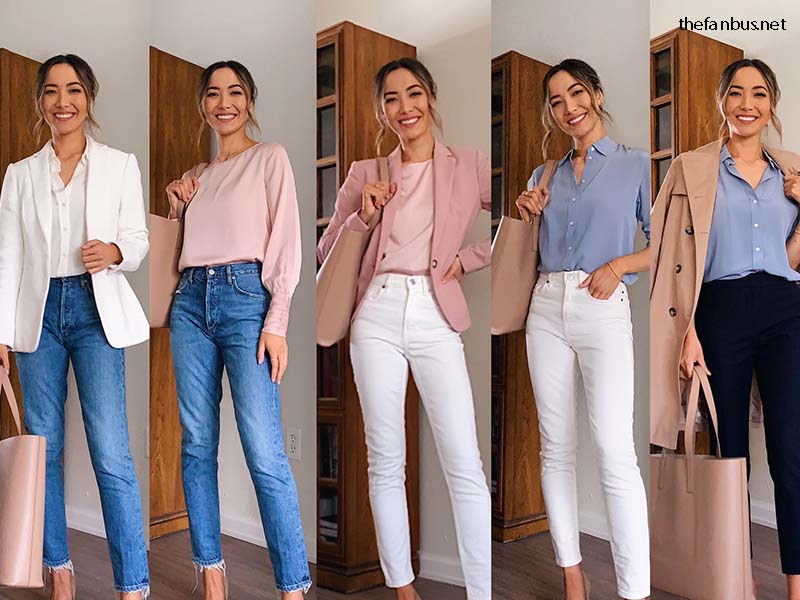Business casual for women has evolved over time and can vary depending on the workplace, industry, and region. Understanding the appropriate attire for a business casual environment can help women feel confident, professional, and comfortable. This guide will explore what constitutes business casual for women, tips for building a business casual wardrobe, and how to adapt to different settings while maintaining professionalism.
Defining Business Casual for Women
Business casual is a dress code that strikes a balance between formal business wear and casual, relaxed clothing. For women, it often includes items that are stylish yet comfortable, professional yet approachable. The idea is to present a polished look without the formality of suits or other strictly professional outfits.
Key characteristics of business casual for women include
Polished appearance
Clean, neat, and well-fitted clothing.
Comfortable yet professional
Practical clothing that allows for ease of movement but doesn’t sacrifice professionalism.
Versatility
Pieces that can transition from work to after-work settings.
No suits required
Unlike traditional business wear, suits and ties are not necessary, though blazers are still commonly worn.
Essential Pieces in a Business Casual Wardrobe for Women
Building a business casual wardrobe requires a mix of staple pieces that can be combined to create numerous outfits. Below are some essentials to include
Blouses and Tops
Blouses are a must for any business casual wardrobe. Opt for tailored, well-fitted tops in neutral or soft colors. Avoid anything too revealing or casual, such as tank tops or graphic tees. Button-down shirts, silk blouses, and tasteful prints can all be great options. Additionally, layering a cardigan or blazer over a blouse adds structure and sophistication.
Popular choices
Silk blouses, cotton button-downs, tailored tops.
Colors
Neutral shades like white, beige, or pastels are common, but soft patterns can also work well.
Blazers
Blazers are an excellent piece for women aiming for a business casual look. A blazer can instantly elevate an outfit, making it more professional. Look for fitted blazers in versatile colors like black, navy, or gray that can easily be paired with a variety of bottoms and tops.
Popular styles
Tailored blazers, cropped blazers, structured blazers.
Best colors
Neutral tones, muted colors, or subtle patterns.
Pants and Trousers
When it comes to bottoms, business casual for women typically includes tailored pants or trousers. Stick to classic cuts, such as straight-leg or slim-fit pants, avoiding overly tight or casual styles like leggings or ripped jeans. Fabrics like cotton, wool, or polyester blends are good choices for comfort and professionalism.
Popular styles
Straight-leg trousers, cropped pants, tailored pants.
Color options
Black, navy, gray, or even khaki and olive are popular.
Skirts
Skirts are a versatile addition to any business casual wardrobe. A knee-length or midi skirt in a neutral color is both professional and stylish. Pencil skirts are a popular option, but A-line skirts or wrap skirts can also be appropriate, depending on the workplace. Make sure the length is appropriate, and avoid anything too short or revealing.
Popular styles
Pencil skirts, A-line skirts, wrap skirts.
Colors and patterns
Neutral colors or subtle patterns like stripes or checks.
Dresses
A business casual dress is another excellent option for women. The key is to choose dresses that are modest and not too formal. Avoid overly tight or casual dresses, opting instead for structured, well-fitted pieces that fall at the knee or below.
Popular dress types
Sheath dresses, wrap dresses, and shirt dresses.
Best colors
Neutral tones like black, navy, and gray are the most versatile.
Footwear
Footwear is a crucial aspect of business casual attire. For women, comfortable yet stylish shoes are essential. Flats, loafers, block heels, and closed-toe shoes are all great options. Avoid overly casual shoes like sneakers or sandals unless your workplace permits them. Opt for neutral tones that complement your outfit.
Popular choices
Loafers, ballet flats, low heels, and closed-toe pumps.
Best colors
Black, nude, brown, or navy.
Accessories
Accessories should be kept simple and professional. A classic watch, delicate jewelry, or a structured handbag can complete a business casual look without overwhelming it. Avoid loud, oversized, or flashy accessories that can detract from your professional appearance.
Popular accessories
Minimalist jewelry, classic watches, structured handbags.
Key advice
Stick to understated, professional pieces that complement your outfit.
Business Casual Dos and Don’ts for Women
While business casual allows for more flexibility than traditional business attire, there are still some guidelines to follow to ensure that your look remains professional.
Dos
Do choose well-fitted clothing
Ill-fitting clothing can appear sloppy and unprofessional. Make sure your clothes are tailored to your body.
Do keep it simple
Business casual doesn’t require extravagant outfits. Stick to simple, clean lines and neutral colors.
Do consider the workplace culture
Some workplaces might be more lenient or strict about business casual attire. Observe how others in your office dress and adjust accordingly.
Do invest in key pieces
Items like blazers, tailored trousers, and classic dresses are worth investing in as they can be used in multiple outfits.
Don’ts
Don’t wear overly casual items
Stay away from overly casual items such as flip-flops, graphic t-shirts, or distressed jeans.
Don’t show too much skin
Avoid low-cut tops, short skirts, or dresses that are too tight or revealing.
Don’t forget about grooming
Hair and nails should be clean and well-maintained, as they contribute to a polished overall look.
Don’t over-accessorize
Stick to simple, professional accessories and avoid anything too flashy or distracting.
Adapting Business Casual to Different Environments
Business casual is not a one-size-fits-all dress code. The interpretation of business casual can vary depending on the industry, company culture, and even geographic location. Below are a few examples of how business casual can be adapted to different environments.
Corporate Settings
In a more traditional corporate environment, business casual for women may lean toward the formal side. Blazers, tailored trousers, and classic pumps are likely to be common, with neutral colors and minimal patterns dominating the wardrobe. It’s important to maintain a professional, polished appearance, especially when interacting with clients or higher management.
Creative Workspaces
In more creative fields like advertising, design, or media, business casual attire can be more relaxed. Women may incorporate more color, patterns, and trendy pieces into their outfits. Dresses with bold prints, statement accessories, or more casual footwear like loafers might be acceptable. While creativity is encouraged, it’s still essential to maintain a sense of professionalism.
Tech Industry
The tech industry is known for its casual dress codes, but business casual still applies, particularly in meetings or client-facing situations. Women in tech may opt for comfortable, functional clothing such as smart blouses paired with chinos or tailored jeans, but it’s important to avoid anything too informal like t-shirts or shorts.
Client-Facing Roles
If your job involves interacting with clients, your business casual attire should reflect a higher level of professionalism. Blazers, skirts, and polished shoes are usually a must, as you represent your company. Neutral, sophisticated colors and minimal accessories work best in these environments.
Seasonal Considerations for Business Casual Attire
Dressing appropriately for the season is also important when curating a business casual wardrobe. The following tips can help you adjust your clothing to match the weather while maintaining a professional look.
Spring and Summer
During the warmer months, opt for lightweight fabrics like cotton or linen. Choose short-sleeved blouses or lightweight dresses, but always make sure that your outfit remains polished. A cardigan or lightweight blazer can be layered for a more professional appearance.
Fall and Winter
In colder months, layering is key. Sweaters, blazers, and scarves can be incorporated into your business casual outfits. Stick to darker, richer colors like burgundy, charcoal, or navy. Knee-length boots, wool trousers, and heavier fabrics can help keep you warm while still looking professional.
Conclusion
Mastering Business Casual for Women
Business casual for women is all about balance. It requires blending comfort and style while maintaining a professional appearance. Whether you’re in a corporate setting, creative industry, or tech environment, knowing the right pieces to include in your wardrobe will ensure you are always dressed appropriately for your workplace.
By sticking to neutral colors, avoiding overly casual items, and investing in timeless wardrobe staples, you can create a business casual look that exudes confidence, professionalism, and personal style. Remember to consider your company culture and the specific expectations of your role, and you’ll always be dressed for success.






